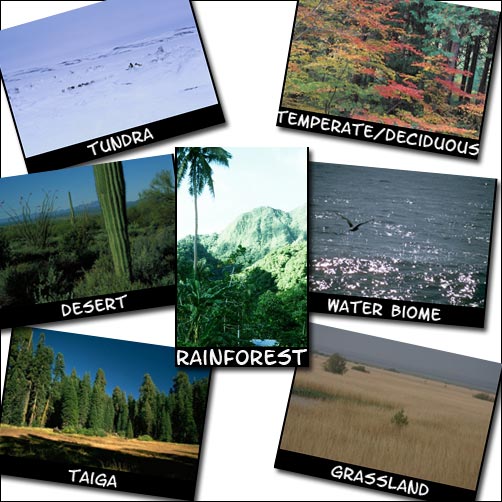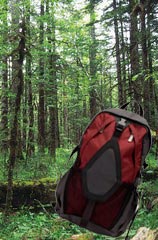So far on this adventure you have seen that there are several different biomes. Biomes do not have definite boundaries. So you can't actually put one foot in the desert and one in a forest at the same time. Because of this, there are many biome types out there. However we can't hike forever, so we'll just take a look at the 7 most common biomes, pictured below:

 Hmmmm...You can carry almost everything in a backpack. Best invention since sliced bread if you ask me. Lucky you, I just happen to have my Travel log with me. It has lots of information about all the other Biomes I have traveled to.
Hmmmm...You can carry almost everything in a backpack. Best invention since sliced bread if you ask me. Lucky you, I just happen to have my Travel log with me. It has lots of information about all the other Biomes I have traveled to.
Each one of the above biomes has a unique climate and wildlife that lives there. The plants and animals and even the microscopic organisms have adapted in order to successfully live in their biome.
Let's look at some of the characteristics of these biomes. Get out your Travel Log and take notes! We've started a notes page for you:
Open this file and use it to record your findings (be prepared to use your notes to complete the assessment for this activity). We started the following Notes Page for you.
Biome Notes
As you read about each of the biomes you will need to record:
- a general description of the biome and if there is a general area where the biome is located.
- a general description of the overall climate.
- the average temperature (include a range of temperatures if appropriate) and annual rainfall amounts.
- the names and pictures of at least two plants and two animals that are characteristic of that biome.
- for each animal or plant you choose you need to describe the adaptations that make them suited to the biome in which they live.
Use Sunny's Travel Log Notes to complete your Biomes Notes page.
- Click on each of the links below to read Sunny's Travel Log on biomes.
- Use this information to complete your own Travel Log Notes Page.
- The information you collect will be used to create a presentation so collect well!
 World Biomes |
NASA's Mission Biomes | Aquatic Biomes
World Biomes |
NASA's Mission Biomes | Aquatic Biomes
Biomes Presentation
You should have a Travel Log full of information on Biomes. You will use the information that you collected to make your first presentation type report to the BV Unlimited Research and Development department.
You are to submit information on 3 of the 7 of the most common biomes listed in the lesson. Even though you are only presenting on 3 of the biomes, you will be responsible for all 7 biomes on the test and quizzes.
You may choose any of the following formats to present your information or if you have an alternate idea, you may contact your instructor for approval.
- Write a descriptive paragraph for 3 different biomes including the information from the instructions below. (The submission should be a total of 3 different paragraphs)
- Write a narrative that addresses the following theme: You are chosen as a contestant in a contest where you will be dropped off in one of the seven biomes left to survive for 14 days with nothing but a small survival pack. Pick your top three biomes in which you think you can survive best, and write an explanation for each as to why you think you could survive there. Make sure that you include all of the necessary information of the assignment in your narrative.
- A presentation created using some type of software such as PowerPoint or Hyper Studio. Arrange your presentation in a bulleted format; avoid paragraph explanations.
Grading Rubric
Before you start your project, use this link to read through how you are going to be graded on this project: Rubric
Information to be included in the presentation.
- A general description of the biome and if there is a general area where the biome is located
- A general description of the overall climate
- The average temperature (include a range of temperatures if appropriate) and annual rainfall amounts
- The names and pictures of at least one plant and one animal that are characteristic of that biome
- For the animal and plant you choose, you need to describe the adaptations that they have that make them suited to the biome in which they live.
If you have completed your presentation click on the Travel Log tab to continue the Extreme Eco Challenge.
Images © clipart.com 2006
|




 World Biomes |
NASA's Mission Biomes | Aquatic Biomes
World Biomes |
NASA's Mission Biomes | Aquatic Biomes